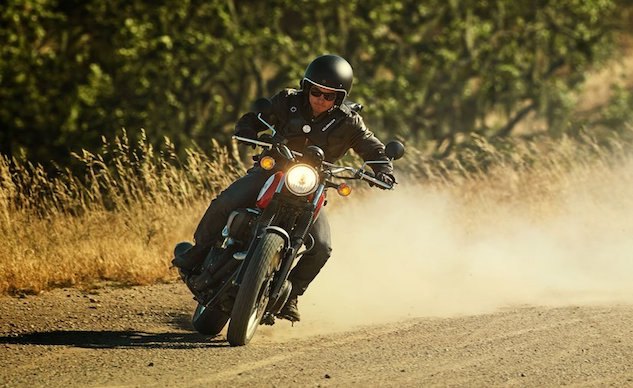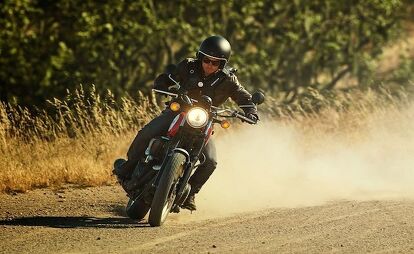Head Shake - A Celebration of Obsolescence
If you stick around long enough it is hard not to be increasingly reminded of one’s own obsolescence. I have stickers on a clipboard I carry to riders meetings at the track that are older than a good many of the racers there. I will admit a preference for those things that demonstrably work rather than those things that are demonstrably new – I was late to the dawn of the replaceable knee puck era in the early ‘80s, I slept through the neon ‘90s never fully appreciating all the pink wheels and leathers, and the Y2K speed hump leathers craze left me flat. But the last thing I was expecting late last year was to be laid bare by an Art Linkletter quote proffered by none other than MO’s esteemed moto-Jarhead, Gabe.
The four stages of man are infancy, childhood, adolescence, and obsolescence.
– Art Linkletter
In Gabe’s Skidmarks column last December he, with an assist from Arthur Gordon Linkletter, pondered the meaning of obsolescence and cautioned of the dangers of getting stuck in a way of thinking, of not evolving. This was about the same time I had confessed to our fearless leader and cutting edge kind of guy, Sean, that I had a flip phone. You can imagine how that was received. The depths of winter on the Chesapeake Bay lend themselves to moments of introspection; I began to have Neolithic misgivings. Just as I was beginning to wonder if I blow cobwebs when I break wind, I was given a sign, courtesy of ESPN.
My deliverance came in the form of Houston Rocket’s rookie Chinanu Onuaku in his NBA debut. The day after Christmas, Onuaku came off the bench to play the remaining minutes of the 4th quarter in the Rocket’s 131-115 win over the Phoenix Suns. This in itself was unremarkable. What was remarkable was what Onuaku did with his free throw opportunities, remarkable in that I had only seen one other person perform such a feat.
Onuaku converted his free throws underhanded – or “granny” style – just as my grandfather did when he played 100 years ago, and just as he used to do with me when I was growing up. To say Onuaku’s style is obsolete is to understate the case, the granny throw is antiquated, it’s ancient, it’s positively pre-Socratic, it also works.
Onuaku summarized his style nicely in an interview with Sports Illustrated: “I really don’t care what people think. As long as I get a bucket, I’m fine.”
Indeed, he is fine, as am I. The fact of the matter is there is a great deal of confusion over just what constitutes obsolete because the definition itself is confused and loaded with pejoratives. If we open the pages of that archaic text brought down from the mountain by those prophets of all things English, Merriam – Webster, we find;
Definition of obsolete
1a: no longer in use or no longer useful b: of a kind or style no longer current: old-fashioned
And therein lies the conundrum, just because something is no longer in use is not to say it is no longer of use, something may no longer be in use for any number of reasons, good, bad, or indifferent, and as Onuaku demonstrates that some-thing may be quite useful depending upon the user.
Suddenly I saw hope where previously there was none, suddenly I was reminded of another glorious sight. Ted Hubbard on the banks of Rockingham back in the 1980s, sitting bolt upright on his BSA B50, clad in his old leathers and work boots, you read that right, work boots, demonstrating to me firsthand the merits of old school.
Ted would go out in practice with the modern bikes and pass traffic like it was stapled to the asphalt, fast as stink and obsolete. Multis, twins, no matter, he would appear like an apparition on the banks sitting up straight as a board – he simply never tucked out of the wind – and leaving. Ted’s old BSA was obsolete, Ted’s helmet and leathers were obsolete, Ted’s riding style was obsolete, hell, Ted was arguably obsolete, and timelessly fast as felonious theft. Ted had one thing that never went out of style, his wrist that only went one way, WFO.
We live in an information age where new ideas are thrown at us constantly. The static to signal ratio in this internet-driven world is hard to discern with all the traffic so I want to make a pitch for not being so quick to discard the obsolete. As Onuaku said so succinctly, “As long as I get a bucket, I’m fine.”
This begs a broader question though: In a technological age where increasingly if we can imagine it we can do it, how should we direct our efforts? At what point does innovation fundamentally alter what we seek to enhance? Is it possible to innovate an experience out of existence?
In 2005 a man in Texas pioneered a way to remotely “hunt” deer via the internet. You could literally sit at home in your bathrobe and remotely shoot a deer in Texas with a high powered rifle. You might be surprised to learn that this technological achievement was condemned by everyone from the NRA to the ASPCA. Mr. Kirby Brown of the Texas Wildlife Association was quoted in a Washington Post article at the time saying, “Hunting is totally experiential. You immerse yourself in it: You’re outdoors, the animal has a fair chance.” And that is precisely the point, hunting, just like motorcycling, is totally “experiential.” But for the pleasure we derive from the experience we would not do it.
We used to wonder what we could do with technology; we are fast discovering the answer is almost anything we wish. We might start asking what we want technology do for us and learning how to say, “No.” In this rush forward we may be leaving a great deal of good behind. Just this year Honda unveiled their new self-balancing bike, it can actually follow you around like a puppy dog. I can imagine what a boon this might be to older or infirm riders; the thought of a self-balancing Gold Wing would be welcomed by most anyone in such circumstances. But given these advances I can see a day coming when we might actually witness the advent of the autonomous motorcycle. At what point does it cease being a motorcycle and become a motorcycle simulator?
And so I was heartened to see Kevin’s interview with Shun Miyazawa, Yamaha’s Motorcycle Project Coordinator, in his latest column. Miyazawa gets it. In explaining the thought behind Yamaha’s Sport Heritage line he was speaking of things I understood:
“I think the possibilities are kind of unlimited, because if you count the number of bikes we produced in the 60 years of company history, there’s a tremendous amount of cool bikes.
“I’ve been speaking to many of those guys in the market the last few years. Almost 80 to 90% of them are wanting to do something based on used bike, but not having enough time or knowledge or skill to make a proper restoration. They are telling us, ‘Yeah, I like the look, I like the feeling and all that, but I don’t want to spend 100 hours before I can actually get to ride the thing.’”
Miyazawa is, in my estimation, on to something here, harnessing today’s technology to enhance the essential two-wheeled experience minus the laborious two-wheeled distractions of the past. This is not simply a retro-appeal design exercise; this is subordinating technology to enhance the fundamental appeal of what motorcycles have always been, and which will never be obsolete, rather than pursuing technology as an end in itself.
Now about a 21st Century Daytona Special redux; perhaps an FZR600-powered FZR400 aluminum chassis number in Yamaha racing colors, or a direct injection RZ350…
Ride hard, ride safe, and look where you want to go.
More by Chris Kallfelz

































Comments
Join the conversation
I enjoyed this article. Too much is made of getting old and becoming "obsolescent". If you engage in life and make a difference to the people around you, you're doing it right. I play hockey with a guy that's 80 (!) and he puts a smile on his teams face every game. I hope I'll be able to say the same one day.
Obsolescence is relative. In the horse world, the saddles and bridles being used for western style riding have changed little in the past hundred years. Some of it is still being made in the old way, by hand, in a small shop. A cowboy from the 1880's could saddle up and ride a horse today, and feel right at home. The legendary Colt .45 ACP model 1911 is still being made, 106 years later, and is still an effective weapon. Nobody rides motorcycles because they are the most efficient transportation. My wife's hybrid car gets about the same mpg as my bike, costs less than a Harley or BMW motorcycle, carries 5 people in air conditioned comfort, but we ride motorcycles for the sensory experience, technology be damned.